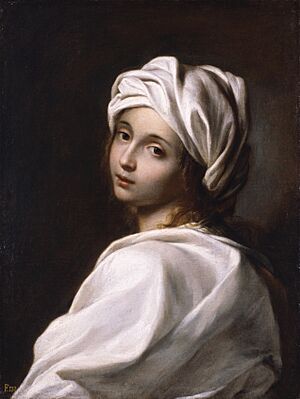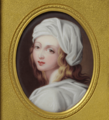Beatrice Cenci facts for kids
Beatrice Cenci (born February 6, 1577, died September 11, 1599) was a young noblewoman from Rome. She became famous for a sad and shocking story. Beatrice lived a very difficult life because of her father, Count Francesco Cenci. To escape his cruel treatment, her family took extreme measures. The events that followed shocked people across Europe. Even though many people felt sympathy for Beatrice, she was executed in 1599 after a well-known trial in Rome. Her story has been remembered for centuries.
Contents
Beatrice's Early Life
Beatrice was the daughter of Count Francesco Cenci, a very rich man who was known for being difficult and often cruel. When Beatrice was seven years old, her mother died. After this, Beatrice and her older sister, Antonina, were sent to live in a small monastery in Rome.
The Cenci family lived in a large palace in Rome called Palazzo Cenci. The family included Count Francesco's second wife, Lucrezia Petroni; Beatrice's older brother, Giacomo; and Bernardo, Francesco's son from his second marriage. They also owned a castle called La Rocca in a small village in the mountains.
A Difficult Family Situation
Count Francesco Cenci treated his family very badly. He had even been in trouble with the law before, but his family's high status often helped him get out of jail early. Beatrice tried to tell the authorities about her father's cruel actions, but nothing effective was done to help her.
When Count Francesco found out that Beatrice had reported him, he sent her and Lucrezia away from Rome. They had to live in the family's castle in the mountains, far from the city.
A Tragic Event
Beatrice, her brothers, and her stepmother felt they had no other choice but to stop Count Francesco's cruel actions. In 1598, while Francesco was staying at the castle, they took drastic action to end his cruelty, trying to make it look like an accident.
Soon, people noticed that Count Francesco was missing. The police from the Pope's government began to investigate. Even though a family friend tried to cover up what happened, the truth was discovered. The four members of the Cenci family were arrested.
The Trial and Execution
The investigation into Francesco Cenci's death revealed important details. The family was found guilty and sentenced to death. Many people in Rome knew how cruelly Count Francesco had treated his family. They protested against the court's decision, hoping to save Beatrice and her family.
However, Pope Clement VIII showed no mercy. He was worried that if he pardoned them, other families might try to harm their relatives for money or power.
On September 11, 1599, at dawn, Beatrice, Lucrezia, and Giacomo were taken to Sant'Angelo Bridge. This was where executions usually happened. Lucrezia was executed first, then Beatrice. Only 12-year-old Bernardo was spared from death. However, he was forced to watch his relatives' execution. After that, he was sent back to prison, and all his family's property was taken by the Pope's family. Bernardo was later released a year later. Beatrice was buried in the church of San Pietro in Montorio.
The Legend of Beatrice Cenci
Beatrice Cenci has become a symbol for the people of Rome. She represents standing up against powerful and unfair rulers. It is said that every year, on the night before the anniversary of her death, her ghost appears at Sant'Angelo Bridge, carrying her head.
Beatrice's Influence on Art and Stories
Beatrice Cenci's sad and dramatic story has inspired many artists, writers, and musicians over the centuries.
- Plays and Books:
* Percy Bysshe Shelley wrote a famous play called The Cenci: A Tragedy in Five Acts in 1819. * The French writer Stendhal wrote a short story called "Les Cenci" in 1837. * Many other writers, like Francesco Domenico Guerrazzi, Alberto Moravia, and Stefan Zweig, have written novels or plays about her. * Nathaniel Hawthorne's novel The Marble Faun (1860) talks a lot about a possible portrait of Beatrice Cenci and her story.
- Music and Opera:
* Several operas have been created about Beatrice, including Beatrix Cenci by Alberto Ginastera and Beatrice Cenci by Berthold Goldschmidt. * A musical drama called Beatrice Cenci was created in 2006.
- Paintings and Sculptures:
* The famous Italian painter Caravaggio may have been inspired by Beatrice's execution for his painting Judith Beheading Holofernes. * An American sculptor named Harriet Goodhue Hosmer created a statue called Beatrice Cenci in 1857. * The early photographer Julia Margaret Cameron created a series of photos inspired by Beatrice Cenci in 1866. * A famous painting, possibly by Guido Reni, is thought to be a portrait of Beatrice Cenci. This painting is mentioned in many books and films.
- Films:
* The 1969 Italian film Beatrice Cenci, directed by Lucio Fulci, closely follows the historical events of her life. * The painting of Beatrice Cenci is shown in the 2001 film Mulholland Dr. * The character Cenci in the film Secret Ceremony is named after the Beatrice legend.
Gallery of Portraits
Images for kids
See also
- List of people executed in the Papal States













